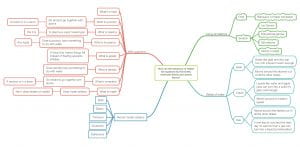I wanted to start this blog post by answering the driving question. But first I am going to explain the name that I game this blog post “I like Dalton models”. If you didn’t already know, John Dlaton was a creator of one of the most famous atomic models, there have been so many different ones but I find Dalton’s to be the most simplistic and easiest to understand. Here is the dalton model for a nitrogen particle.
Now back to the driving question, for this project it was “How can the behaviour of matter be explained by the kinetic molecular theory and atomic theory”. My answer is through simulations and fun but educational games. Atoms and molecules are so small you need a special microscope to see them. So people make simulations and games to make people understand what happens when certain things are added to atoms and molecules. For example if heat is added to a ice cube more kinetic energy is added which makes the molecules move faster and leads it to become water. And if you add even more, the molecules will start moving a lot faster which will lead it to become a gas. The opposite happens when you make it colder because the kinetic energy will start getting taken away which leads the molecules to go slower and slower which will lead them to become water and then ice. At the beginning of the project, we did a mind map like we do for most projects and also at the end we did one. Here they both are:
What most people did for this project was make a simulation on scratch showing all of what I was just talking about, but there was another option, that option was to make a game and I did. To make the game I used a free coding website called scratch and in the end my game explained the kinetic molecular theory and the atomic theory in a fun way. It took a wile to fully understand how scratch worked but after time it got easier and easier. My game is technically a rip off of Super Mario bros. but I made it a little different in ways that I needed to. Like the gumbas and Koopa troopas are all different molecules that form fire, oh and the character is a ice cube by the way. Also during the game every couple levels it gets warmer and warmer which leads the character to become water and then vapour. And wile that is happening there is a GIF playing in the top right showing you what the molecules are doing wile they are in a certain state.
If you want to check out my game click here super ice man
And if you were wondering, the code in scratch looks like this:
And now for the curricular competencies. They are always mostly the same but just a little different for certain things about the project.
Questioning and predicting: All class time is used efficiently for learning without distractions.
I feel that I did this one good because the only time that I wasn’t doing something productive was during break and the only time that I would be watching something is a video on how to do certain things in scratch.
Scientific communication: Several different atoms/molecules, different states of matter, and particle motion are represented in the finished product. A historical model of the atom is chosen and implemented.
I did this one good because I added all those things even if it made the game screen a little cluttered and I used more than one historical model of the atom and molecule.
Reasoning and analyzing: An interactive Scratch coded matter simulator or game is created with logical conditions and functional user controls.
I did this one good because I made it very interactive by being able to move the character in any direction and well it is a game.
In conclusion, I never really knew how to code before this project but I already feel that I am a pro at using scratch.
Make sure to go check out these two peoples blogs because they helped me a whole lot with understanding scratch.




Leave a Reply